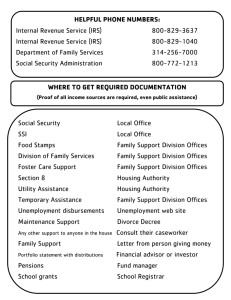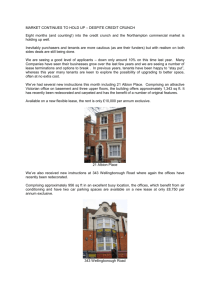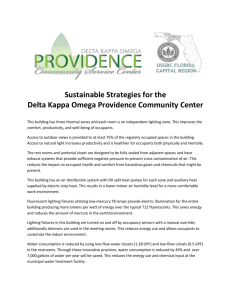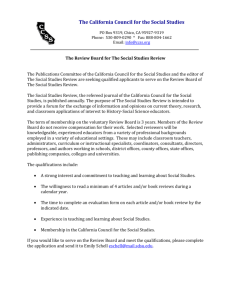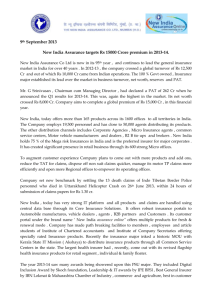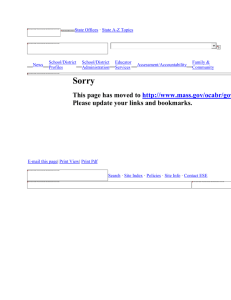OFFICE BUILDING - BRE projects website
advertisement
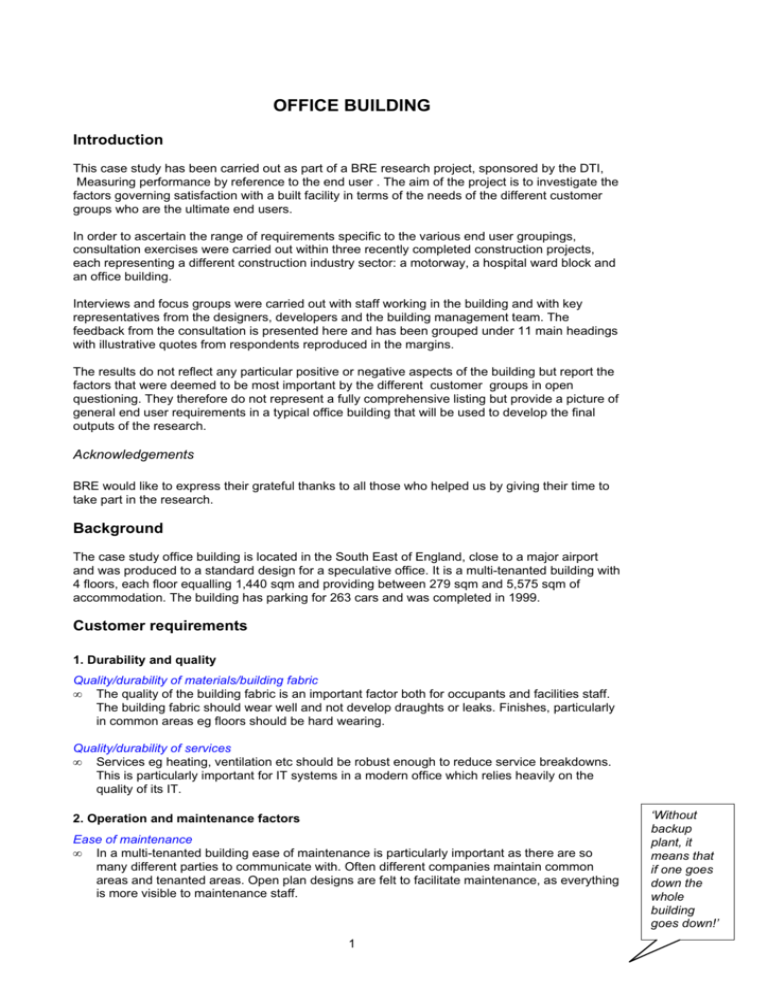
OFFICE BUILDING Introduction This case study has been carried out as part of a BRE research project, sponsored by the DTI, Measuring performance by reference to the end user . The aim of the project is to investigate the factors governing satisfaction with a built facility in terms of the needs of the different customer groups who are the ultimate end users. In order to ascertain the range of requirements specific to the various end user groupings, consultation exercises were carried out within three recently completed construction projects, each representing a different construction industry sector: a motorway, a hospital ward block and an office building. Interviews and focus groups were carried out with staff working in the building and with key representatives from the designers, developers and the building management team. The feedback from the consultation is presented here and has been grouped under 11 main headings with illustrative quotes from respondents reproduced in the margins. The results do not reflect any particular positive or negative aspects of the building but report the factors that were deemed to be most important by the different customer groups in open questioning. They therefore do not represent a fully comprehensive listing but provide a picture of general end user requirements in a typical office building that will be used to develop the final outputs of the research. Acknowledgements BRE would like to express their grateful thanks to all those who helped us by giving their time to take part in the research. Background The case study office building is located in the South East of England, close to a major airport and was produced to a standard design for a speculative office. It is a multi-tenanted building with 4 floors, each floor equalling 1,440 sqm and providing between 279 sqm and 5,575 sqm of accommodation. The building has parking for 263 cars and was completed in 1999. Customer requirements 1. Durability and quality Quality/durability of materials/building fabric • The quality of the building fabric is an important factor both for occupants and facilities staff. The building fabric should wear well and not develop draughts or leaks. Finishes, particularly in common areas eg floors should be hard wearing. Quality/durability of services • Services eg heating, ventilation etc should be robust enough to reduce service breakdowns. This is particularly important for IT systems in a modern office which relies heavily on the quality of its IT. 2. Operation and maintenance factors Ease of maintenance • In a multi-tenanted building ease of maintenance is particularly important as there are so many different parties to communicate with. Often different companies maintain common areas and tenanted areas. Open plan designs are felt to facilitate maintenance, as everything is more visible to maintenance staff. 1 ‘Without backup plant, it means that if one goes down the whole building goes down!’ • • • Finishes should be chosen for ease of cleaning. Some types of flooring eg marble, slate, wood require special treatment or damage can occur. It should be possible for routine maintenance of the IT systems to be carried out with minimum disturbance to staff ie not turning off of systems during working hours. Routine maintenance of plant is facilitated by the provision of back-up plant, ie a pair of chillers, boilers etc. Without backup, maintenance has to be carried out outside working hours which is then more expensive. Accessibility for cleaning and maintenance • There should be easy access to all areas for cleaning/maintenance. For example the building should be designed so that everything is accessible from a cherry picker (atrium etc), roofs are strong enough to walk upon or, the need to go up there in the first place should be designed out. • Ease of access to building services is important for maintenance and for those who are carrying out fit out. Support for the facilities team • The needs of facilities personnel should be taken into account in the building design. This should include maintenance staff accommodation and the provision of storage eg for cleaning items and other equipment. • In a large office block, a service lift or service stairs (in addition to the outside fire escapes) should be provided. 3. Environmental conditions Thermal comfort • Thermal comfort is very important. The office should not be too hot or too cold and the temperature should not be erratic or have hot and cold spots. The temperature can be a problem when more people are accommodated in an area than it was originally designed for. It is not always appreciated that they, together with their computers generate additional heat. Environmental comfort is an important factor for developers for whom such issues can be a major source of tenant complaints. Electric lighting • Good electric lighting is an important factor in an office. Inadequate lighting can have effects on performance, particularly if much of the work carried out involves close reading. • Avoiding glare is important when much of the work involves VDUs. It is not always possible to completely eliminate glare on computer screens but this can be well controlled by window blinds. Access to windows/daylight Access to daylight can impact upon occupants well being and performance. Even in a light building staff may be positioned too far from a window so that they sometimes feel the need to go outside to walk round the building to compensate. Atria are a positive way of increasing the amount of daylight penetrating the building, eg to internal meeting rooms, which are much more pleasant than windowless rooms. • In a large office not everyone can be seated near a window but it is important to be able to look out at the view, as it keeps staff in touch with reality. Large windows mean that even those not seated near one can see out easily. • Air quality • Poor air quality eg stuffiness, low humidity can have impacts on the health of occupants. Symptoms could include tiredness, headaches, skin irritation as well as reduced concentration and stress which in turn could lead to increased absenteeism and turnover. • Incidences of low humidity may be noticed by occupants where air conditioning is not installed. Aural comfort/noise • An office should not be too noisy to work in as this disturbs many occupants and prevents them from concentrating on their work. 2 ‘I should not be aware of the impact of the building and its environment on my work and the work of my dept. It should be unnoticeable, like a good referee.’ ‘Dark offices are soul destroying and bad for concentration’ It is not so bad if you hear your own colleagues as you might pick up useful information, but you need be able to blank out noise from others.’ • In open plan offices in particular, there are often complaints about unsatisfactory noise levels as sound travels so easily throughout the office. To address this issue, protocols about the use of mobile phones and bans on loud talking can be introduced. Other suggestions include the use of filing cabinets and added boxes as a barrier and full height glass partitioning between sections. (although this can interfere with ventilation system performance) Acceptable level of control over environmental conditions • Personal control of the heating and ventilation systems is an important factor governing satisfaction but it is acknowledged that it is difficult to provide in open plan offices. An adequate number of thermostats should be provided and the occupants should be given instructions in how to adjust these themselves. Ideally most people would like to be able to control ventilation by opening windows, but realise that this is not always practical because of external noise or other issues. • In open plan areas there are often few controls for lights but task lighting can provide individual control. Meeting rooms and cellular offices should be provided with individual lighting controls. 4. Business aims (inc. financial factors) Value for money • Value for money is an important factor in a tenanted building. There has to be a balance in priorities between the cost of the project and the satisfaction of the final tenant — if it is too cheap at the expense of quality, it will not fulfil their needs and therefore be difficult to let. Support for business drivers • One of the main business drivers in a speculative office block, is the amount of net lettable space available in the building. A key issue is to reduce the number of non-lettable areas and achieve the maximum net to gross so as to maximise rental income. • The ability to let the building easily is important. The floor plates can be designed to be divided to accommodate a variety of client needs eg for tenants requiring smaller spaces, which improves lettability. • For tenant companies, the ability to reduce space usage is a key business aim. This is often achieved by increasing density by introducing open plan working and reducing the number of cellular offices. Operating costs • Rental costs are an important factor for tenants who also require a reasonable level of running costs, eg heating and electricity. • For a developer, it is important to strike a balance between the most effective systems to meet the capital cost aspiration but which are also cost effective in use. Flexibility to support churn • In a speculative building where tenants may be responsible for their own fit out, one of the most important factors is flexibility in the building services. If this is taken account of in the design, they are then able to fit out their own areas to meet their own needs and make changes to accommodate churn. • Flexibility of space is also important. The design should take into account the needs of changing tenants and potential occupiers, eg reducing the number of columns to facilitate space planning etc. 5. Sustainability /environmental issues Waste recycling • Environmental issues such as waste recycling and energy efficiency were not highlighted by many respondents although the recycling of paper, cups etc was seen as important. • Environmental impact issues are not often a key factor in the construction of a building unless there is a criterion to use recycled products etc. 3 ‘Good sustainable office design can often go hand in hand with good business.’ Energy efficiency • Movement sensors on lights are thought to be a good idea as most people in open plan offices do forget to turn them off. Occupants may feel that it would be a good thing if their building was a low energy building but they would not know how to find this out. • Generally clients are not felt to be interested in sustainability as they see it as costing more, and tenants are not usually interested in a 1-2% saving from increased energy efficiency. However sustainability can be related to cost saving eg suitable orientation reducing the load on chiller plants and this would be welcomed. 6. Access factors Adequacy of transport to site • The building should be easily accessible by public transport and facilities should be provided for bicycle users eg bike sheds. • If staff travel to the offices by car, ease of car parking for staff just outside the building is very important to them. Car parking is also important to the developer from a lettability point of view. However it is not always possible to provide enough car parking space because of the constraints of local planning rules. Solutions to this problem include allocated car parking spaces and the provision of alternative car parking in the vicinity. • Car parks should be provided with barriers, to provide control by the front desk to prevent non authorised users. • The car park should be easy to access and adequate parking for visitors should be provided, especially if clients visit for business meetings. This should be well signed and pleasantly laid out. Visitors car parks are often seen as an afterthought, and are put at the back of the building like a tradesman s entrance, which does not give a good impression. Location • The geographical location of an office building is an important factor for an occupying business. Easy access from roads, proximity to motorways, the airport, trains etc makes it easy for staff to travel to and from work. By meeting these criteria, a building can beneficially affect the recruitment of staff. It also allows ease of access for clients visiting the offices and for staff travelling to meetings. For some staff it is also very important that they do not have far to travel to work, particularly for those with childcare responsibilities. In general, a great deal of time can be wasted commuting to work. • Location is also very important as it impacts on lettability, rental levels and choice of tenant. The airport is a very important location — being closest to the hubs attracts the highest rents. Also when letting offices at airports, the planning authority stipulates that the users have to be air related, ie anyone who needs to be in an airport environment eg airlines, cargo handling etc. Proximity to local amenities • Proximity to local amenities, shops etc is an important factor. Many staff like to be able to do their shopping at lunchtimes without driving too far and also like to be able to get out of the office for lunch occasionally. Adequacy of access into/within the site • Ease of access to the building both for able-bodied users and the disabled, is important. There should be adequate lifts and stairs for the number of occupants. • Stairs should be of good quality rather than simply fire stairs as are found in so many buildings so that occupants are encouraged to use them. • Good access for the disabled is generally better in a modern building as suitable lifts, disabled toilets etc are usually designed in. Attention should be paid to the design of doors, which are often too heavy for wheelchair users to negotiate without help. Wayfinding • The building should be designed so that it is easy to find one s way around, once inside eg visual accessibility. • The quality of the reception area is important. It should allow the easy flow of people through the building and not look overcrowded. 4 ‘In some locations you could waste a whole day in travelling to and from meetings.’ • Signs should be clear both outside and inside the building. This is particularly important in a multi-tenanted building as it is easy for visitors to get lost. Clear directions and signs should be provided outside the building, in the lobby, on each floor and on the entrance doors to each company. 7. Health and safety factors Adequate provision for personal security • Although security within a building is very important, if it is too strict it can work against communication, eg if swipe cards are needed to move between floors. • If staff work late regularly, provision should be made for 24-hour security. • Car parks should be secure, particularly at night. They should be well lit and CCTV cameras installed. • Security can be enhanced by the design of the front desk and reception area so that anyone who enters the building can be seen easily. Adequate provision for safety including fire safety • In many offices, power/communications outlets are located in floor boxes. These can be a trip hazard if they are being used (wires, left open), as are heating/ventilation grilles if located in the floor. • Adequate fire safety is very important. Compliance with fire regulations can affect the design of the building and its facilities, eg the provision of catering facilities and the design of atria. Adequate provision for health/hygiene • The provision of toilet facilities on each floor saves time for staff. • Visitors toilets should be provided on the ground floor so that they do not have to walk through the offices. This causes disturbance and impacts on confidential working. • The number of toilets should be adequate for the number of staff who work in the building, allowing for any possible increases in numbers. • Shower facilities are useful for staff who travel to work by bike. • First aid facilities should be provided ie a sick room. This is particularly important in an open plan building so that if anyone is taken ill there is somewhere to take them, eg to lie down or sit quietly or to administer first aid. 8. Amenities (features that are ‘nice to have’ but do not directly impact on business) Adequacy of catering facilities • Common spaces, eg kitchens for the use of staff are an important facility. In large office buildings kitchen areas should be provided on each floor with microwave, sink, fridges etc. These kitchen areas can be provided with seating and double up as informal meeting areas if they are large enough. • If kitchens are located within an open plan area, they should be screened adequately so if people want to talk they will not disturb those working in the office area. • Kitchens should be well ventilated so that cooking smells do not drift through the office. In a large office block it is helpful if a caf or canteen is provided in the building, particularly if it is in an out of town location. This saves time during lunch hours and if seating areas are included, staff can eat there instead of at their desks or use it as an informal meeting area, even when the cafe is shut. Vending machines can provide refreshments out of hours. Adequacy of other amenities for staff • The provision of informal rest areas is important to provide a place for staff to leave their desk at breaks. This could be a coffee lounge, seating in the atrium or in the grounds etc. Many offices do not provide such areas and staff therefore have to stay in the office to eat lunch etc. • Informal meeting spaces should be provided, particularly in open plan offices. Without these staff have to gather round someone s desk for informal, ad hoc meetings and this can be very disturbing for colleagues. Tables away from the main desk areas could provide these areas if there is room. Such informal meetings are important for encouraging creativity and communication. 5 It is nice to be able to sit and have a coffee away from the desk.’ If you want to be seen as a world class business they will take you more seriously if the office looks good.’ 9. Image Appearance • The internal and external appearance of a building is an important factor for clients/ customers who visit the office, as it increases the credibility of the organisation and its staff. • The psychological aspect of the image reflected is important for staff — it reflects the regard in which they and their jobs are held by the company. It also impacts on staff morale and self respect. In theory this could have an impact on recruitment in terms of giving a positive impression when recruiting external candidates. • High quality common areas are very important as these increase lettability. The quality of the finishes should be chosen to suit what a potential tenant would expect eg in a mid range building they would not want marble but clean clinical finishes. • An atrium is often seen as a positive feature in a building as it provides light, greenery etc. It can also be used as an additional informal meeting area if seating is provided. General cleanliness/tidiness General cleanliness and tidiness of the offices and the common areas is important for the image it presents to visitors. It also has impacts on morale, and health. • Common areas eg lifts and toilet areas often present problems due to ownership issues. Adequate storage should be provided for rubbish and other items that can be left around. • 10. Features that provide support for carrying out function/job effectively Adequacy of accommodation/arrangement of space • An adequate number of good quality meeting rooms should be provided. There should be a variety of sizes of meeting rooms to accommodate different needs, provided with presentation facilities eg walls suitable for projection. • In open plan offices, meeting rooms are particularly important as they can be used for informal chats, confidential discussions and concentrated work as well as for meetings. • Attention should be paid to space layout, particularly in an open plan office to avoid battery chicken syndrome . The office should lend itself to imaginative layouts of workstations as rows of desks are seen as reminiscent of a call centre. This is easier to achieve in smaller open plan areas as the space appears less vast. • Occupants should have adequate personal space and not feel cramped or overcrowded. Too little room between desks can have negative impacts on the ability to carry out one s job because of the increased disturbance and disruption. Adequacy of furniture and other equipment needed to carry out ones job • Desks and chairs should be suitably designed for the work carried out eg for PC use. If the desks are not big enough for a computer, screen etc, users have to sit in uncomfortable positions that affect their posture and can cause neck and back strain. Furniture should be adjustable to accommodate individual differences. • IT and other office equipment eg printers, photocopiers should be easily accessible. • In many jobs, adequate layout space is very important for staff if their work entails the use of large plans, maps etc. This can be provided by the provision of table space for laying out papers both within the open plan areas and in meeting rooms. Adequacy of storage space • The provision of adequate storage space is often an issue in offices. Although with the increased use of IT there have been moves towards paperless offices, many jobs involve paper based information, eg records, that has to be kept for a number of years.. A variety of storage should be provided for items in regular use and for medium and longer-term storage. • Facilities should be provided for secure storage for confidential items and personal possessions. • Inadequate storage can create a messy, cluttered impression, which is felt to effect relationships with colleagues, and causes wasted time in looking for things. This can have a negative impact on work performance as well as upon the image of the building. 11. Psychological factors that support the culture of the organisation 6 Support for communication • Many offices are now laid out as open plan space but occupants have mixed views about the impact of open plan on communication. Staff can overhear each other and share information easily and in a totally open plan office there is more access to senior staff. Occupants can also see when colleagues are in or out. However an open plan office layout can also act as a barrier to communication as there is nowhere to go to talk without disturbing colleagues if additional informal areas are not provided. Support for a sense of belonging/corporate identity • An office building can reinforce a sense of corporate identity, particularly if there are a number of employees from the same company working there. They can feel closer to their colleagues and therefore much more a part of the organisation. A sense of belonging is seen as very important as it increases commitment to the company. Support for new ways of working • Hot desk areas are a useful feature for staff who are not based in the building and who need somewhere to work when they visit. Support for confidentiality • The design of the office should support confidential work, eg phone calls, one to one discussions etc. • Open plan layouts are thought to constrain confidentiality, as there is often no private space. Staff have to find a free meeting room for confidential meetings. This can be particularly difficult for managers who do not have their own office when dealing with staff/management issues. • In open plan offices when staff need privacy to hold confidential conversations or meetings they often have to book a meeting room. An adequate number of meeting rooms should therefore be provided to allow for this use and these should be well soundproofed so that conversations cannot be heard outside. Support for collaborative team working • Collaborative working can be constrained because of the disturbance factor in an open plan office or by the isolation of a cellular layout. • The design of the office should provide scope for reinforcing a team identity by enabling areas to be separated by cupboards, partitions, or walls so that each team has its own space. • There should be a means of providing a character or identity by personalising the team space eg via the use of colours, signage etc. • Sockets, floor grilles, partitions etc should be positioned so that it is easy to move desks around and create any changes in layout to facilitate teamworking. Support for concentrated work • When work requires creativity and concentration the provision of some quiet areas away from the open plan area is very important. Some well-soundproofed, cellular, individual rooms for quiet work and confidential one-to-one meetings are helpful. • Privacy can be increased by the provision of screens and acoustic partitions. A lack of peace and quiet that prevents staff from doing their work can depress people and often leads them to work from home or come in early/stay late. Communication and consultation When considering the construction of a new office building it is important to consult all end users at the appropriate time so that the factors that impact on their specific role are considered and to allow them to exert genuine influence over decision making. In the case of an office project, end users include: • Directors • Line management • Finance department • Human Resources/personnel department • Facilities staff • Occupying staff 7 It is useful to consult people, even if it is just a case of giving them a few alternate designs to choose from. You cannot please everyone but this might help. • Clients/customers/visitors However in the case of a speculative development, it is not always possible to enter into any discussion with the ultimate occupiers of the building at an early stage, as it is not known who these will be. There are also a number of different parties responsible for the design at different stages ie the original design team will not be involved with the final fit out as this is dealt with by the occupying organisations and their space planners who design the layouts etc. Most occupants appreciated this but would like to be involved in some way even at the fit out stage to ensure that their needs are catered for. Communication during occupation is often difficult in a multi-tenanted building eg for the reporting of defects or maintenance issues. In the case study building this problem has been overcome via a tenants/user group that meets once a month. These meetings are attended by representatives of the different occupiers and the building managers and discuss any building related issues that have arisen. Tenant/user groups such as these can also provide useful post occupancy feedback to the clients and designers that can be used to inform the thinking for future development projects. 8 9
